The Practice of Natural Family Planning Versus the Use of Artificial Birth Control:
Family, Sexual and Moral Issues
Natural Family Planning
It is essential to understand what is meant by natural family planning in order to realize why it produces so many benefits to the marriage. In general, Natural Family Planning (NFP) is defined as methods for achieving or postponing pregnancy that are based on observations of naturally occurring signs in the woman's body that inform her of the fertile and infertile phases of her cycle. Authentic Natural Family Planning never interferes with the transmission of life; its sincere openness to the Will of God and respect for life is its most vital virtue. Various natural methods are being taught throughout the world that respect the natural law and are accepted by most cultures and religions. The Ovulation Method (OM) of Natural Family Planning is at present the most widely used method because it is the easiest to learn and simplest to follow.
The NFP survey participants in the following study were generally practicing the Ovulation Method. This Method is neither the old "Rhythm" method nor the "Temperature" or Sympto-thermal method. It is based on the simple recognition of natural signs of fertility that appear for a few days during the woman's fertile cycle. It is important to recognize that a woman is only fertile for approximately 100 hours per cycle during her reproductive years, whereas a man is potentially fertile every day from puberty onward. The advantages of the OM that influence the practice of natural family planning within the marriage are not only spiritual, but also psychological and physical. It is simple to learn and safe to practice and does not depend on regularity of cycles for effectiveness. It has no physical side effects, and it does not interfere with the conjugal act nor does it involve distasteful procedures. When practiced for the avoidance of pregnancy, it is 98 effective in postponing pregnancy, even among the poorest of the poor in developing countries1, or among couples of no religious persuasion, as in China2. Women discover signs of fertility never fully understood before. The OM has proven extremely helpful in assisting seemingly infertile couples to conceive a baby. It fosters communication and mutual respect between the spouses as they accept responsibility in their decision to achieve or postpone pregnancy. It seems to bring peace and greater intimacy to the marriage. When practiced generously and not for selfish or materialistic reasons, the spouses respect life and the privilege given to them of transmitting life.
Figure 1 depicts the simplicity of the OM by teaching women to recognize the natural signs of her fertility comparing it to the fertility and infertility of the land.
Figure 1: The Ovulation Method Chart3

Figure 2: Effectiveness Rates of OM
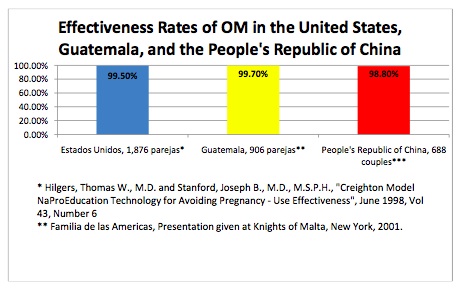
Artificial Birth Control
In contrast, couples who use artificial methods of birth control seem to experience disturbing spiritual, and psychological as well as physical risks to their body and soul. The normal functions of the woman's body are disrupted by the ingestion of dangerous chemicals or the use of mechanical devices. Often the woman is not informed of the internal effects on her body, nor of the abortifacient effect of most artificial methods of birth control (birth control pills, Norplant, Depo-Provera injections, intrauterine devices), as they interfere with the normal growth and development of the endometrial lining, turning it hostile to the implantation of a new human life already conceived a few days earlier. Young people are persuaded early in life, through amoral sex education, to experiment prematurely, becoming promiscuous with different partners, increasing the prevalence of venereal diseases and endangering their fertility. The burden on the poor is particularly serious because of the often subhuman conditions they live under and the lack of medical facilities to treat the serious side effects of artificial birth control. Artificial methods do not encourage intimate communication between spouses as they transfer the burden of responsibility primarily on the woman. Artificial birth control places an artificial barrier between husband and wife and limits the most intense physical expression of human love. Such methods facilitate the couple's use and misuse of each other rendering them unable to fully appreciate the gift of their sexuality. Birth control, sterilization and abortion are responsible for the present population implosion of the West now rapidly expanding to the developing world.4
Methodology of Data Collection
The data used to examine the NFP survey came from a survey conducted during the summer and fall of 2000 by Family of the Americas Foundation (FAF), an international, educational non-profit organization that promotes NFP, headquartered in Dunkirk, Maryland. FAF staff contacted NFP teachers from various regions of the U.S. and asked them to solicit former students (women who had been instructed in Natural Family Planning) to participate in the survey. Teachers sent names and addresses of willing participants to FAF headquarters. Family of the Americas staff mailed questionnaires to 683 prospective respondents. 505 women returned useable completed questionnaires to an independent investigator retained by Family of the Americas Foundation to provide data entry and descriptive statistical analysis. The survey achieved a 74% response rate. Sampling for the NFP study was nonrandom, although the investigator did attempt to generate a representative sample of women in the U.S. who practice NFP. Participants were drawn from 31 states, making the NFP sample national in scope.
Sample Characteristics
The comparison results in different parts of this paper are from three distinct sources: 1) a survey conducted by Family of the Americas Foundation, directed by Robert Lerner, Ph. D. an independent evaluator, from here on addressed as the Natural Family Planning Survey (NFP), which is the first-ever survey of its kind to examine the impact of Natural Family Planning on a wide variety of family, sexual and moral issues; 2) the National Survey of Family Growth (NSFG) which was carried out by the U.S. Government's National Center for Health Statistics; and 3) the General Social Survey (GSS) conducted by the National Opinion Research Center (NORC) on a continuous basis, a well-known and highly regarded national survey research organization, whose data collection efforts in this instance is funded by the U.S. Government's National Science Foundation Social Science Data Program.
The NFP survey asked questions of 505 couples 21 to 66 years of age; the National Survey of Family Growth (NSFG) queried 10,847 women 15 to 44 years; the General Social Survey (GSS) questioned 19,786 women 18 years of age and older; and the sub-group (Ever Married Catholic) pertains only to GSS respondents who are Catholic, and who have been married at some time in their lives, (including those who are currently married). Another sub-group from the NSFG survey was also analyzed that compared Catholics from the NFP survey and Catholics from the NSFG survey who ranged in age from 21 to 44. These sub-groups, both Catholics within the same age range, gave us a more accurate comparison.
The NFP respondents had taken instruction in Natural Family Planning at least three to over ten years ago. 92% of the women were White, 6% Hispanic and the remaining 2% Other. Their age ranged from 21 to 66 years, with a sample mean of 39.8 years (median = 39), and they were married on average 15.4 years longer than in the other studies. When asked for their religious denomination 91% were Roman Catholic, 8% described themselves as Protestant/Christian and only 4 respondents out of the total sample of 505 specifically indicated no religion. In general, these women were highly educated: 45% were college graduates and 15% reported completing a Master's degree or higher. Median income fell between $50,000 and $60,000 annually, with approximately 20% describing themselves as working full-time. An additional 26% describe themselves as part-time workers and 42% list their occupation as that of a homemaker. Regarding their current marital status, 98% identified themselves as married and only one woman described herself as divorced, and 18 women (3.56%) described themselves as having been divorced at some time during their life.
Review of NFP Survey
Following is a closer scrutiny of the NFP survey including a few graphs that have been chosen to exemplify some of the most significant findings of the surveys. The questions asked in the NFP survey were formatted after those in the NSFG and GSS surveys for easier comparisons. This report is based on "A Survey of Users of Natural Family Planning and Other American Women" by Robert Lerner, Ph.D. that was prepared for Family of the Americas Foundation.
Pope John Paul II has written that sexuality is "the arena of constant conflict between two fundamentally different value systems, two fundamentally different ways of determining norms of behavior, the utilitarian and the personalistic." He goes on to remind us that "the love which is the content and commandment of the Gospels, can be combined only with the personalistic, not with the utilitarian norm."5 Artificial birth control epitomizes the battle between the personalistic and the utilitarian norms in their application to sexual behavior and sexual morality. To be sure, one of the many great contributions of Pope John Paul II has been to situate the natural law tradition of the Church's moral teaching in personalistic terms.
Figure 3: NFP Study Data - Interest in NFP Over Other Methods
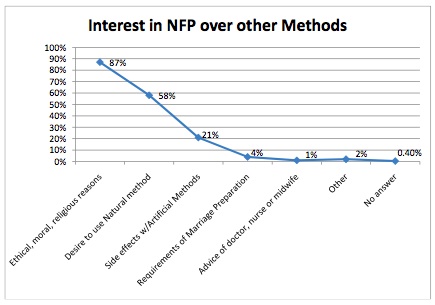
As seen in Figure 3, interest in NFP is higher for "ethical, moral or religious reasons", for "desire to use a natural method" and for "side effects with other methods" than for "requirements of marriage preparation." It is disturbing to read that less than 5% were interested because the Church "required it" for marriage preparation and over 20% were interested because of "side effects from artificial birth control". This suggests that the majority of the NFP respondents learned about natural family planning not because it was required of them, but because they had a desire to follow the natural law. The low percentage of "advice of doctor, nurse, or midwife" suggests that the majority in the medical profession remain unaware or disinterested in a "natural alternative" and remain unwilling to recommend it. When looking for help in having or spacing their children, couples usually turn to their physician and, if they are practicing their faith, turn to their priest. It appears that the medical profession is negligent in encouraging couples to practice Natural Family Planning, a method that encompasses good health, good morals, and strengthens their marriage.
Figure 4: NFP Study Data - Reasons for Taking NFP Class
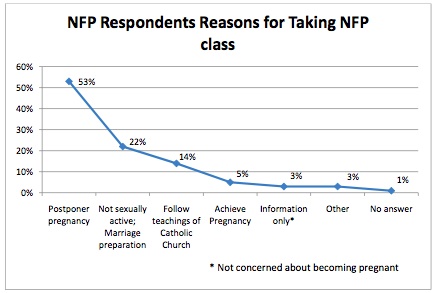
In comparing the reasons for learning about natural family planning as shown in Figure 4, the majority (53%) of NFP respondents were "postponing pregnancy" while only 22% learned about it during marriage preparation and 14% to follow the Church's teachings. The survey also revealed that when NFP couples were asked why they wanted to practice NFP, the overwhelming response (87%) was "for moral, religious and ethical reasons." Can we conclude then, that if Catholic couples had been taught the benefits of discipline and self-control as the ideal virtue in marriage, together with NFP during their marriage preparation classes, they most likely would have chosen to respect and follow the natural law from the very beginning of their marriage? Instead, most couples fall prey to artificial birth control not knowing of the Church-approved "natural alternative". It is critical to mention the high percentage of sterilizations (almost 50%) of women and men in the U.S., who have willingly submitted themselves to voluntary mutilation of their most precious reproductive organs6. This procedure is anti-life, and possibly even more damaging morally and psychologically than abortion. A woman who has aborted her baby and consequently repents is then able with her husband to become co-creators of new life with God. Conversely, the sterilization of a man or a woman is almost impossible to reverse both physically and financially. The physical, psychological and spiritual effects of sterilization are often detrimental to the marriage. A scientific study on the association of sterilization and divorce should be conducted and would be of great interest to society.
Support of Husbands, Spousal Communication and Intimate Conversation
NFP respondents were asked how generally supportive their husbands were regarding NFP. The majority (58%) of wives said their husbands were very supportive, an additional 13% said their husbands were supportive, while another 4% said their husbands were somewhat supportive. In total, general support from the husbands for NFP was 75%, which is impressive. The survey also revealed that 89% of NFP couples share a deep intimacy with their spouse. Very few had husbands who were hostile to the practice of NFP. Only 1% had husbands who were unsupportive and 1% had husbands who were very unsupportive.
Figure 5: NFP Study Data - Communication With Husband
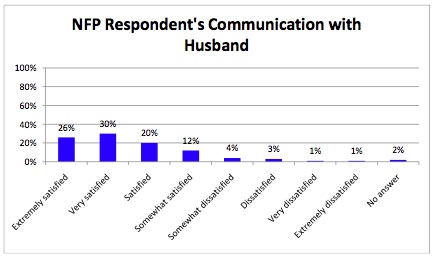
When asked how satisfied they were with communication with their spouse, 88% of the NFP women responded positively. The high level of communication between spouses is without a doubt the fundamental ingredient that contributes to the success of any marriage. As this sharing and bonding develops, both husband and wife embrace mutual responsibility in postponing or bringing new lif e into the world each cycle. It is not surprising, therefore, that the divorce rate among couples who practice NFP is so low. As the results of Figure 5 indicate, 26% are extremely satisfied with their communication with their husband, 30% are very satisfied, and 20% are satisfied, comprising 76% of the total. 3% are dissatisfied while 1% are very dissatisfied and 1% are extremely dissatisfied. NFP fosters communication and intimate conversation between spouses, as they need to be aware of their combined fertility and infertility.
When asked how often they had intimate conversations with their spouse, 13% said every day, 20% said almost every day, and 31% said quite frequently for a total of 64%. One quarter (25%) responded that they had intimate conversations occasionally, and 6% said rarely, while only 2% said they almost never have such conversations. When communication and intimate conversation becomes habitual between spouses, it seems reasonable to presume that potential concerns would be addressed prior to becoming divisive problems. Our study showed that the level of communication between couples of a high income bracket and couples of a low income bracket were not different. A recently concluded, unpublished study in Guatemala among low income couples practicing NFP showed an impressive level of cooperation (93.3%) and communication (90%) between them. This confirms that the educational, and economic status of the couple has no bearing on the success in cooperation and communication within the marriage.
How Artificial Birth Control Use Is Linked to Sexual Promiscuity, Abortion and Divorce Among the NFP Study
Artificial Birth Control Use Among NFP Women Reporting Pre-Marital Sexual Relations
Of the 505 NFP cou ples surveyed:
- 243 women in the NFP study (49%) reported being sexually promiscuous before marriage.
- Of these 243 women, 204 (84%) reported using artificial birth control at some time in their lives. 39 (16%) reported never having used artificial birth control.
- The average number of sexual partners reported by women who were sexually promiscuous before marriage was 3. This average was significantly different from the average (1 partner) for women who were not sexually active before marriage.
Premarital Sexual Activity Among NFP Women Reporting Abortions
The responses of the NFP group regarding sexual promiscuity and having had an induced abortion are:
- 25 women (5%) reported having an induced abortion at some time during their lives.
- Of these twenty-five, 24 (96%) reported being sexually active before marriage. Only 1 (4%) reported not being sexually active before marriage.
- The average number of sexual partners reported by women who had induced abortions during their lives was 4. This average was significantly different from the average (2 partners) for women who did not report having had an induced abortion.
Premarital Sexual Relations Among NFP Women Reporting Divorce
The responses regarding divorce among the 505 NFP couples showed that 18 women (4%) reported being divorced at least once in their lives:
- Of these eighteen, 14 (78%) reported being sexually active before marriage. 4 (22%) reported not being sexually active before marriage.
- The average number of sexual part ners reported by women who had been divorced during their lives was 4. This average was significantly different from the average (2 partners) for women who did not report having been divorced. Part of this difference is due to the fact that most of the divorced women later remarried.
Artificial Birth Control Use Among NFP Women Reporting Divorce
Studying the artificial birth control use among the women reporting divorce shows another connection:
- Of the eighteen women who reported being divorced at least once in their lives, 17 (94%) reported using artificial birth control at some time in their lives. Only 1 woman (6%) who reported never using artificial birth control was divorced.
- Out of the total sample of 505, the average number of sexual partners reported by women who ever used artificial birth control was 2. This average was significantly different from the average (1 partner) for women who never used artificial birth control. In the NFP data, the divorce rate among women who reported never using artificial birth control is 0.002.
How Abortion, Divorce, and Promiscuity are Linked to the Use of Artificial Birth Control as Shown in the Following Adjusted Tabulations
The connections are becoming clear. Abortion, divorce, and multiple sexual partners are all statistically associated with artificial birth control. Abstinence before marriage and chastity within, is not only the message taught with Natural Family Planning, it is the essential message that should be taught to Young men and women before they become entrenched in the dominant artificial birth control mentality that is so harmful to marriage and family.
In our thirty-two years of experience, seldom have we counseled couples that have not been wounded by the experience of using artificial birth control. They are surprised and often angry at not having been privy to such vital and simple knowledge as NFP earlier in their lives. Artificial birth control has not only affected the physical and psychological health of many, but for some it appears to have scarred their souls forever. It does not seem surprising that the consequences of violating the natural law has reduced their dignity as human persons often to the detriment of their own marriage.
Even though 91% of the couples in our survey were Catholic, most of them (65%) had violated Church teaching on artificial birth control, and 5% of the women had induced abortions. Nevertheless, as we study their replies in the survey, a change of heart appears to have taken place in their married life and seems to correlate with the practice of natural family planning.
Adjusted Tabulations
Dr. Robert Lerner, the principal investigator recognized the importance of incorporating adjusted tabulations in the report. This way the NSFG sample and the NFP sample are more directly comparable to each other. It is useful to use some kind of adjustment procedure because the NFP sample consists almost entirely of married Catholics who range in age from 21 to 66 years old, while the NSFG sample consists of women of all faiths including those who have never been married, and who range in age from 15 to 44 years old. These factors - religious affiliation, age, ever married or not - may play a role in accounting for the results obtained thus far.
Therefore, all the adjusted results from the NSFG survey are only from those respondents who are Catholic, who have been married at some time in their lives (including those who are currently married), and who range in age from 21 to 44 years old. Similarly, all the adjusted results from the NFP survey are only from those respondents who are Catholic, who have been married at some time in their lives, (including those who are currently married), and who range in age from 21 to 44 years old. These results are referred to as "adjusted tabulations".
Artificial Birth Control Use By NFP And NSFG Women
Concerning the use of artificial birth control, a majority of couples in both adjusted subsamples have used some kind of artificial birth control, but a substantial majority has done so in the NSFG group.
Figure 6: NFP Adjusted and NSFG Adjusted Data - Methods Ever Used
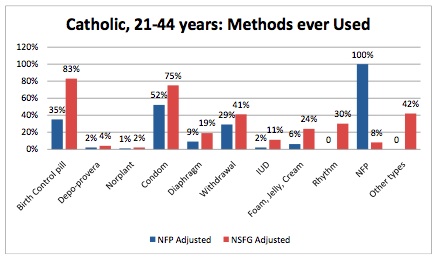
The percentages of the types of methods ever used are significantly fewer among the NFP participants. Responses indicate that the NFP Catholics have used birth control pills (35%), Depo-Provera (2%), Norplant (1%), diaphragms (9%), IUDs (2%), foams, jellies or creams (6%), condoms (52%) and withdrawal (29%). NSFG Catholics, 21-44 years of age have used birth control pills (83%), Depo-Provera (4%), Norplant (2%), diaphragms (19%), IUDs (11%), foams, jellies or creams (24%), condoms (75%) and withdrawal (41%). The most widely used methods are the condom and the birth control pill. A majority of both adjusted groups have used the condom, but the percentage is higher for NSFG Catholics (75%) than for NFP Catholics (52%). 83% of NSFG Catholics have used birth control pills while only 35% NFP Catholics had used them. Among the NSFG Catholics, 21-44 years of age, 30% practiced the old calendar Rhythm and only 8% have practiced a more modern method of Natural Family Planning - either the Sympto-thermal or the Ovulation Method.
Figure 7: NFP Adjusted and NSFG Adjusted Data - Current Methods Used
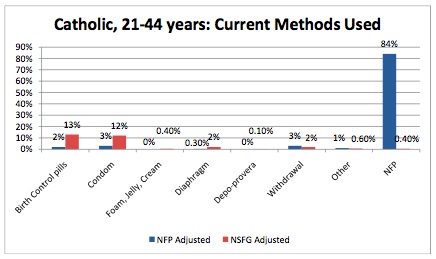
Of the current artificial birth control being used by the Catholics, 21-44 years of age in the NSFG: 13% use birth control pills, 12% use condoms, .4% use foam, jelly or cream, 2% use the diaphragm, .1% use Depo-Provera, 2% use withdrawal, and .6% use other methods. Among the Catholics, 21-44 years of age in the NFP group, 84% practice NFP and the use of artificial birth control is considerably lower: 2% birth control pills, 3% condoms, 0% foam, jelly or cream, .3% diaphragm, 0% Depo-Provera, 3% withdrawal and 1% other.
One might believe that with Catholic couples, widespread use of artificial birth control would be less prevalent, as would an induced abortion. Unfortunately, history has shown that when artificial birth control becomes a widely accepted practice, the legalization of abortion usually follows. Catholics are no less immune to governmental pressures and societal influences, concurrent with the mass media propaganda from the pharmaceutical industry that has aggressively promoted the widespread use of artificial birth control, sterilization and abortion. Our experience confirms that both men and women instinctively perceived a lack of fulfillment with artificial birth control and lamented that they had not been informed of a natural, harmless and simple alternative by their physician or church leader.
Incidence of Induced Abortions
Figure 8: NFP, NFP Adjusted, NSFG, and NSFG Adjusted Data
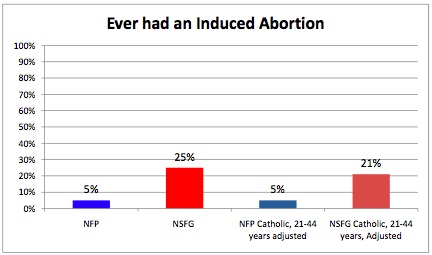
Among the NFP respondents, only one in twenty women (5%) had induced abortions (the same in the NFP Adjusted), which is twenty percent fewer than the NSFG (25%). One in five (21%) of the NSFG Catholic, 21-44 years Adjusted, had induced abortions, which is 4% lower than the NSFG respondents. Even though our NFP survey did not ask if the induced abortions took place prior to practicing NFP, we feel that theydid. We are basing this belief on the 21% abortion rate reported by the NSFG Catholics, who are not practicing NFP, and who have a considerably higher number of induced abortions. Our NFP group's induced abortion rate might have risen to 21% had they not been introduced to NFP. It appears that the low abortion rate could not be due only to their religiosity, because 65% had violated the Catholic Church's teachings on artificial birth control. As Catholics, we believe that when we are in the state of sanctifying grace respecting the Ten Commandments and not violating the Natural Law, God pours His blessings upon us to strengthen our faith and free will to remain faithful to His teachings. For this reason, the spiritual graces and benefits of respecting God's Moral and Divine Laws seem to be essential in marital happiness and conjugal harmony.
According to a 1995 study, using the same NSFG data as part of their calculations, it was reported that the proportion of abortions resulting from contraceptive failure was 58%7. As reported by the American Life League, 49% of pregnancies among American women are unintended and half of these are terminated by abortion. Judging by the widespread use of artificial birth control in the NSFG survey (94.3%), and their confusion in recognizing right from wrong, (see Figures 16 and 17), it is not surprising that the abortion rate is 25%. Further studies using current information may show an even greater percentage of abortions, especially if chemical abortion methods such as the morning after pills and the RU-486 are included.
Next Page:
Comparative Divorce Rates
1,
2
Article copyrights are held solely by author.
[ Japan-Lifeissues.net ] [ OMI Japan/Korea ]